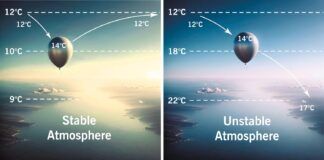The phenomena can happen in any snowstorm where the conditions happen to be ripe for lightning formation. It turns out that lake (or ocean) effect snow has a higher-than-average incidence of thundersnow where cold air passes over warm, moist water. Even though the temperatures are cold, there’s enough vertical development due to the temperature difference to create the convection needed for lightning (and thunder). One key ingredient seems to be a difference of at least 25 degrees C between the water and the air at about 5000 feet.
The other situations that can brew the right conditions are pockets of warm air rising rapidly in the mountains, the northwest quadrant of synoptic snow storms, and a trough of warm air aloft (denoted TROWAL on charts).
One of the oddities of thundersnow is that the snowfall deadens the sound of the thunder. Normally, thunder can be heard for miles. Thundersnow is rarely heard more than a mile away—but it’s pretty loud when you’re right next to it. —R.T.




